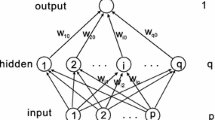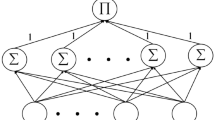Abstract
Pi-sigma neural network (PSNN) is a class of high order feed-forward neural networks with product units in the output layer, which leads to its fast convergence speed and a high degree of nonlinear mapping capability. Inspired by the sparse response character of human neuron system, this paper investigates the sparse-response feed-forward algorithm, i.e. the gradient descent based high order algorithm with self-adaptive momentum term and group lasso regularizer for training PSNN inference models. In this paper, we mainly focus on two challenging tasks. First, since the general group lasso regularizer is no differentiable at the original point, which will lead to the oscillation of the error function and the norm gradient during the training. A key point of this paper is to modify the usual group lasso regularization term by smoothing it at the origin. The advantage of this processing is that sparse and efficient neural networks can be obtained, and the theoretical analysis of the algorithm can also be obtained. Second, the adaptive momentum term is introduced in the iteration process to further accelerate the network learning speed. In addition, the numerical experiments show that the proposed algorithm eliminates the oscillation and increases learning rate in computation. And the convergence of the algorithm is also verified.







Similar content being viewed by others
Explore related subjects
Discover the latest articles, news and stories from top researchers in related subjects.References
Haykin S (2008) Neural networks and learning machines. Prentice-Hall, Upper Saddle River
Ilias K, Michail P (2021) Predictive maintenance using machine learning and data mining: a pioneer method implemented to Greek railways. Designs 5(1):5
Kocak C et al (2019) A new fuzzy time series method based on an ARMA-type recurrent Pi-Sigma artificial neural network. Soft Comput 24(11):8243–8252
Bas E et al (2018) High order fuzzy time series method based on pi-sigma neural network. Eng Appl Artif Intell 72:350–356
Liu T, Fan QW, Kang Q et al (2020) Extreme learning machine based on firefly adaptive flower pollination algorithm optimization. Processes 8(12):1583
Wang J, Cai QL et al (2017) Convergence analyses on sparse feedforward neural networks via group lasso regularization. Inf Sci 381:250–269
Fan QW, Zhang ZW, Huang XD (2022) Parameter conjugate gradient with secant equation based Elman neural network and its convergence analysis. Adv Theory Simul. https://doi.org/10.1002/adts.202200047
Shin Y, Ghosh J (1991) The pi-sigma network: an efficient higher-order neural network for pattern classification and function approximation. Int Jt Conf Neural Netw 1:13–18
Mohamed KS, Habtamu ZA et al (2016) Batch gradient method for training of pi-Sigma neural network with penalty. Int J Artif Intell Appl 7(1):11–20
Fan QW, Kang Q, Zurada JM (2022) Convergence analysis for sigma-pi-sigma neural network based on some relaxed conditions. Inf Sci 585:70–88
Wu W, Feng G, Li X (2002) Training multilayer perceptrons via minimization of sum of ridge functions. Adv Comput Math 17(4):331–347
Zhang NM, Wu W, Zheng GF (2006) Convergence of gradient method with momentum for two-layer feedforward neural networks. IEEE Trans Neural Netw 17(2):522–5
Augasta MG, Kathirvalavakumar T (2013) Pruning algorithms of neural networks—a comparative study. Open Comput Sci 3(3):105–115
Fan QW, Liu T (2020) Smoothing \(L_0\) regularization for extreme learning machine. Math Probl Eng 2020:1–10
Xu CY, Yang J et al (2018) SRNN: self-regularized neural network. Neurocomputing 273:260–270
Setiono R, Hui LCK (1995) Use of a quasi-newton method in a feedforward neural network construction algorithm. Neural Netw IEEE Trans 6(1):273–277
Zhang J, Morris AJ (1998) A sequential learning approach for single hidden layer neural networks. Neural Netw 11(1):65–80
Augasta MG, Kathirvalavakumar T (2011) A novel pruning algorithm for optimizing feedforward neural network of classification problems. Neural Process Lett 34(3):241–258
Hrebik R, Kukal J, Jablonsky J (2019) Optimal unions of hidden classes. Cent Eur J Oper Res 27(1):161–177
Sabo D, Yu XH (2008) Neural network dimension selection for dynamical system identification. IEEE International Conference on Control Applications. pp 972-977
Setiono R (1997) A penalty-function approach for pruning feedforward neural networks. Neural Comput 9(1):185–204
Wang J, Wu W, Zurada JM, (2011) Boundedness and convergence of MPN for cyclic and almost cyclic learning with penalty. Proceedings IEEE International Joint Conference on Neural Networks (IJCNN), pp 125–132
Zhang H, Wu W, Liu F, Yao M (2009) Boundedness and convergence of online gradient method with penalty for feedforward neural networks. Neural Netw IEEE Trans 20(6):1050–1054
Huynh TQ, Setiono R (2005) Effective neural network pruning using cross-validation. Proceedings IEEE international joint conference on neural networks(IJCNN). pp 972–977
Hagiwara M (1994) A simple and effective method for removal of hidden units and weights. Neurocomputing 6(2):207–218
Whitley D, Starkweather T, Bogart C (1990) Genetic algorithms and neural networks: optimizing connections and connectivity. Parallel Comput 14(3):347–361
Fletcher L, Katkovnik V, Steffens FE, Engelbrecht AP (1998) Optimizing the number of hidden nodes of a feedforward artificial neural network. Proceedings IEEE world congress on computational intelligence. The international joint conference on neural networks, pp 1608–1612
Belue LM, Bauer KW (1995) Determining input features for multilayer perceptrons. Neurocomputing 7(2):111–121
Fan QW, Peng J, Li H, Lin S (2021) Convergence of a gradient-based learning algorithm with penalty for Ridge Polynomial Neural Networks. IEEE Access 9:28742–28752
Zhang H, Wang J, Sun Z et al (2020) Feature selection for neural networks using group Lasso regularization. IEEE Trans Knowl Data Eng 32(1):659–673
Loone SM, Irwin G (2001) Improving neural network training solutions using regularisation. Neurocomputing 37(1):71–90
Xu ZB, Zhang H et al (2012) \(L_{1/2}\) regularization: a thresholding representation theory and a fast solver. IEEE Trans Netw Learn Syst 23(7):1013–1027
Fan QW, Niu L, Kang Q (2020) Regression and multiclass classification using sparse extreme learning machine via smoothing group \(L_{1/2}\) regularizer. IEEE Access 8:191482–191494
Mohamed KS, Wu W et al (2017) A modified higher-order feed forward neural network with smoothing regularization. Neural Netw World 27(6):577–592
Zhou L, Fan QW, Huang XD, Liu Y (2022) Weak and strong convergence analysis of Elman neural networks via weight decay regularization. Optimization, pp 1-24. https://doi.org/10.1080/02331934.2022.2057852.
Tibshirani R (1996) Regression shrinkage and selection via the lasso. J R Stat Soc Ser B (Methodological) 58(1):267–288
Zou H (2006) The adaptive lasso and its oracle properties. J Am Stat Assoc 101(476):1418–1429
Yuan M, Lin Y (2006) Model selection and estimation in regression with grouped variables. J R Stat Soc 68(1):49–67
Friedman J, Hastie T, Tibshirani R (2010) A note on the group lasso and a sparse group lasso, Statistics
Noah S, Friedman J, Hastie T, Tibshirani R (2013) A sparse group lasso. J Comput Graph Stat 22(2):231–245
Kang Q, Fan QW, Zurada JM (2021) Deterministic convergence analysis via smoothing group lasso regularization and adaptive momentum for sigma-pi-sigma neural network. Inf Sci 553:66–82
Author information
Authors and Affiliations
Corresponding author
Additional information
Publisher's Note
Springer Nature remains neutral with regard to jurisdictional claims in published maps and institutional affiliations.
This work was supported by the Natural Science Basic Research Plan in Shaanxi Province of China (No.2021JM-446) and the 65th China Postdoctoral Science Foundation (No.2019M652837), the Natural Science Foundation Guidance Project of Liaoning Province (No.2019-ZD-0128).
Rights and permissions
Springer Nature or its licensor (e.g. a society or other partner) holds exclusive rights to this article under a publishing agreement with the author(s) or other rightsholder(s); author self-archiving of the accepted manuscript version of this article is solely governed by the terms of such publishing agreement and applicable law.
About this article
Cite this article
Fan, Q., Liu, L., Kang, Q. et al. Convergence of Batch Gradient Method for Training of Pi-Sigma Neural Network with Regularizer and Adaptive Momentum Term. Neural Process Lett 55, 4871–4888 (2023). https://doi.org/10.1007/s11063-022-11069-0
Accepted:
Published:
Issue Date:
DOI: https://doi.org/10.1007/s11063-022-11069-0




